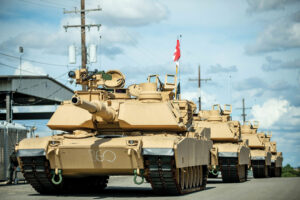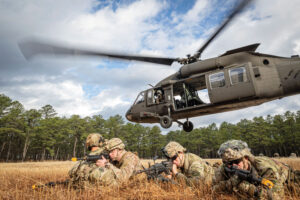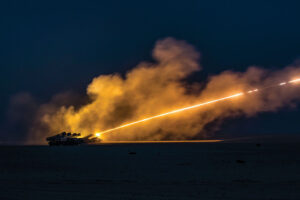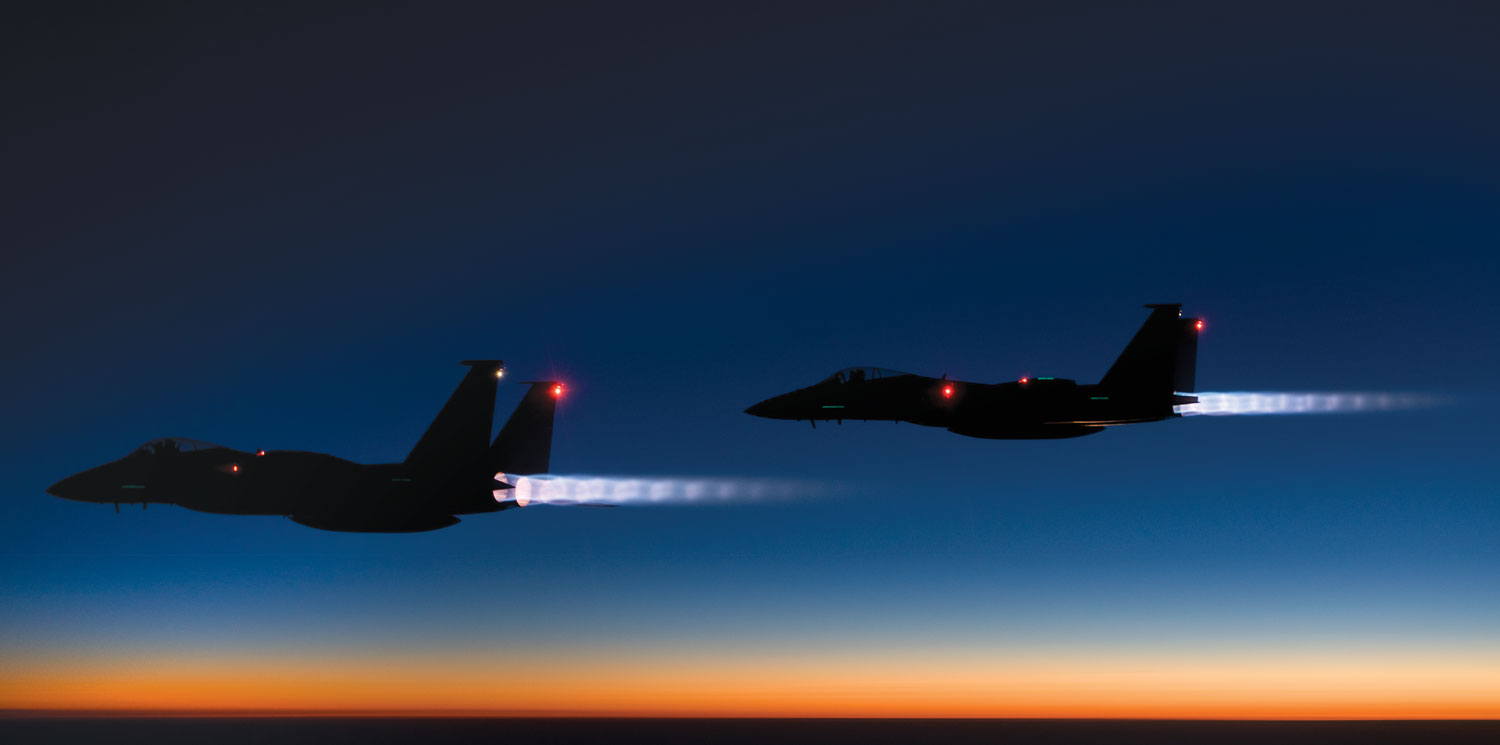
Equipping the Guard
Army National Guard
M1 Abrams
 DESCRIPTION: Main battle tank
DESCRIPTION: Main battle tank- PRIMARY MANUFACTURER: General Dynamics Land Systems
- ENTERED ARMY SERVICE: 1980
- BASIC VARIANTS: M1A1 AIM SA and M1A2 SEPv2
- GUARD USAGE: The fleet of more than 400 tanks is a mix of the analog M1A1 Abrams Integrated Management–Situational Awareness tanks and the fully digital M1A2 System Enhancement Package version 2. They reside across five armored brigade combat teams and three combined-arms battalions.
- UPDATE: Most units have the M1A1 AIM SA. Two ABCTs and one CAB have the M1A2 SEPv2, which is what active-component units operate. Both variants have deployed with the Guard overseas in recent years. The mixed fleet creates interoperability problems and complicates the supply chain. Meanwhile, the Army has started fielding the M1A2 SEPv3, which has more electrical power, better network capabilities and stronger armor than the v2. It’s an even bigger leap forward over the AIM-SA. The three Guard ABCTs with the AIM-SA tanks will begin receiving it in fiscal 2023 as part of the Army’s Abrams Upgrade Program. The 278th Armored Cavalry Regiment headquartered in Tennessee is first in line. All three should have the Army’s latest tank by the end of fiscal 2025. Modernization of the Guard Abrams fleet is a NGAUS legislative priority.
Bradley Fighting Vehicle
 DESCRIPTION: Tracked, armored vehicle
DESCRIPTION: Tracked, armored vehicle- PRIMARY MANUFACTURER: BAE Systems
- ENTERED ARMY SERVICE: 1981
- BASIC VARIANTS: M2A2 ODS SA, M2A3 and M3 (cavalry version)
- GUARD USAGE: The fleet of more than 600 Bradleys is a mix of the rebuilt M2A2 and M2A2 Operation Desert Storm-Situational Awareness and the most advanced variant, the digital M2A3 and M3A3. They reside across five armored brigade combat teams and three combined-arms battalions.
- UPDATE: Most Guard Bradleys are the rebuilt M2A2 ODS SA thanks to a recently completed multiyear modernization program. The active component has the more advanced M2A3A3, which the Army likes to pair with the M1A12 SEPv2 tank. Two Guard armored brigade combat teams and one combined-arms battalion have the most advanced variant. The primary difference is the A3 is fully digital, the A2 is not. Additionally, the A3s have the Commander’s Independent Viewer, which the A2s lack. The Army has begun fielding a more advanced Bradley, the M2A4, to active-component units. This allows the service to begin cascading replaced A3s to Guard units with the A2s in 2023. The 278th Armored Cavalry Regiment headquatered in Tennessee is first in line. The A4 will be the end of the Bradley. The service wants to begin replacing it with the Optionally Manned Fighting Vehicle before the end of the decade. Modernization of the Guard Bradley fleet is a NGAUS legislative priority.
Stryker
 DESCRIPTION: Highly deployable, wheeled armored vehicle
DESCRIPTION: Highly deployable, wheeled armored vehicle- PRIMARY MANUFACTURER: General Dynamics
- ENTERED ARMY SERVICE: 2002
- BASIC VARIANTS: Infantry Carrier Vehicle, Mobile Gun System and eight additional variants. They come in two configurations: flat-bottom hull or double-V hull. The “double-V” hull provides added survivability and mobility.
- GUARD USAGE: Pennsylvania’s 56th Stryker Brigade Combat Team and the Washington-based 81st Stryker Brigade Team are the Guard’s only SBCTs. All of the Guard Strykers have flat-bottom hulls.
- UPDATE: A pair of modernization programs will bolster the punch and survivability of many Strykers. One replaces the infantry carrier’s .50 caliber machine gun with a turret-mounted 30mm cannon. Fielding began in 2018 with an active-component unit stationed in Europe. The other program will add bigger engines, better electronics and the “double-V” hulls to flat-bottom Strykers. Work is also underway on a new anti-aircraft variant and another one with a 50-kilowatt high-energy laser weapon. The two Guard SBCTs are scheduled to get Stryker DVH-A1 platforms by fiscal 2028.
AH-64 Apache
 DESCRIPTION: Attack helicopter
DESCRIPTION: Attack helicopter- PRIMARY MANUFACTURER: Boeing
- ENTERED ARMY SERVICE: 1984
- BASIC VARIANTS: AH-64D Longbow and AH-64E Guardian
- GUARD USAGE: Three Guard attack reconnaissance battalions across four states (North Carolina, Utah and a unit split between Texas and Mississippi) operate the AH-64D Apache. South Carolina’s 1st Attack Reconnaissance Battalion, 151st Aviation Regiment received the AH-64E this year.
- UPDATE: The fleet is the result of the Army following the letter of the National Commission on the Future of the Army recommendation in 2016 to retain four Apache battalions of 18 aircraft in the Guard. Not long ago, it was eight battalions of 24. Army Apache battalions need 24 aircraft to deploy, which meant ARBs had to scrounge six aircraft to deploy, and three battalions did go to Afghanistan after 2016. Help is beginning to arrive. The Army plans to field 24 of the more advanced E models to each Guard ARB by the end of 2026. Modernization of the Guard Apache fleet is a NGAUS legislative priority.
CH-47 Chinook
 DESCRIPTION: Twin-engine, tandem-rotor cargo helicopter
DESCRIPTION: Twin-engine, tandem-rotor cargo helicopter- PRIMARY MANUFACTURER: Boeing
- ENTERED ARMY SERVICE: 1962
- BASIC VARIANT: CH-47F, Special operations forces use the MH-47
- GUARD USAGE: The Guard has its full authorization of 165 Chinooks spread over 24 states. Until recently, most were D models, many of which were more than 30 years old. Newer F models have better situational awareness and dramatically improved flight control. Nevertheless, Guard Chinooks saw extensive duty in Afghanistan, where the CH-47 has been a workhorse due to its ability to perform at higher altitude.
- UPDATE: A multiyear Army purchase resulted in a steady stream of F models flowing into the Guard in recent years to replace old CH-47Ds. Some were brand new, fresh from the Boeing factory in Ridley Park, Pennsylvania, or rebuilt with many new parts. Others were cascaded from other units. Boeing, at the Army’s request, developed a new variant of the F model, the CH-47F Block II, which can carry heavier loads. Army leaders planned to buy nearly 500 before deciding to shift the resources to Future Vertical Lift, but Congress did not go along. It would be a stretch, however, to say the program is now completely restored.
UH-60 Black Hawk
 DESCRIPTION: Versatile utility helicopter
DESCRIPTION: Versatile utility helicopter- PRIMARY MANUFACTURER: Sikorsky, a Lockheed Martin Company
- ENTERED ARMY SERVICE: 1979
- BASIC VARIANTS: UH-60A, UH-60L, HH/UH-60M, UH-60V
- GUARD USAGE: The Black Hawk is the Guard’s go-to aviation asset both at home and abroad. The Guard operates roughly 900 UH-60s, about 40% to the Total Army fleet, but more than 150 are original A models that are on average 39 years old and beyond their expected useful lives.
- UPDATE: Plans project the UH-60A to be in the fleet until 2025. However, the horizon depends on the continued acquisition of new M models, which have greater range and lift, and the upgrade of suitable older aircraft. There is positive news on this front: fiscal 2022 defense appropriations include 33 new M models and 24 rebuilt V models. The UH-60L-to-V program is supposed to provide refurbished helicopters with many of the attributes as new M models. It’s behind schedule, but fielding has begun. Illinois’ 1st Assault Helicopter Battalion, 106th Aviation Regiment this year became the first Guard unit in the Army to receive V models. The program is designed to produce 48 V models a year. Black Hawk modernization has long been a NGAUS legislative priority.
UH-72A Lakota
 DESCRIPTION: Light utility helicopter
DESCRIPTION: Light utility helicopter- PRIMARY MANUFACTURER: Airbus Group
- ENTERED ARMY SERVICE: 2007
- BASIC VARIANTS: The UH-72A now comes in a medevac and security-and-support configurations.
- GUARD USAGE: The force has its full requirement of 212 Lakotas: 105 for support and security, 48 for medical evacuation, 39 for general support and 20 for training. Fielded primarily for domestic use, the Lakota could be more of a deployable asset if upgraded with added crew and fuel-tank protection. The 212 requirement is 64 aircraft less than originally planned.
- UPDATE: Airbus is marketing a new variant, the UH-72B, as a low-operating-cost alternative to the Black Hawk for noncombat missions. It boasts the latest five-bladed main rotor, the Fenestron shrouded tail rotor, two Safran Arriel 2E engines and the Airbus-designed Helionix avionics suite. The Guard is set to receive 17 B models. The first arrived in Arizona earlier this year. Colorado just received two. New Mexico is next on the fielding list. Meanwhile, the existing Lakotas will require lifecycle modifications to sustain the fleet through the next decade.
M142 High Mobility Artillery Rocket System
 DESCRIPTION: Self-propelled, multiple rocket launcher
DESCRIPTION: Self-propelled, multiple rocket launcher- PRIMARY MANUFACTURER: Lockheed Martin
- ENTERED ARMY SERVICE: Tracked version (MLRS) in 1982
- BASIC VARIANT: M142
- GUARD USAGE: The Guard has 12 battalions that fire HIMARS, a wheeled version of the M270 Multiple Launch Rocket System. The design offers a unique shoot-and-scoot capability that enables soldiers to position, engage and rapidly relocate after firing. Many of the units saw action in Iraq and Afghanistan, but most did not perform fire missions.
- UPDATE: Ukraine asked for and received a limited number of systems from the United States. The Ukrainians believe its mobility and 300-mile range could make it a difference-maker against Russian forces.
M109 Paladin
 DESCRIPTION: Self-propelled 155mm howitzer
DESCRIPTION: Self-propelled 155mm howitzer- PRIMARY MANUFACTURER: BAE Systems
- ENTERED ARMY SERVICE: 1963
- BASIC VARIANT: M109A6
- GUARD USAGE: The Guard has 15 battalions that fire the Paladin, a longtime artillery workhorse. Many of the units saw action in Iraq and Afghanistan, but most performed missions other than indirect fire. The new National Defense Strategy and its focus on higher-intensity conflicts renews the importance of traditional artillery. In fact, long-range precision fires is the Army’s No. 1 modernization priority.
- UPDATE: The Army plans to convert every Paladin platform in the force to the M109A7. It blends the traditional turret and gun with a new hull equipped with Bradley components. North Carolina’s 1st Battalion, 113th Field Artillery Regiment received the A7s last year. It was the first Guard fielded the new system. Battalions in Minnesota and Tennessee are scheduled to receive it next year. Additionally, Paladin battalions in both Arkansas and Utah are scheduled to convert to Extended Range Cannon Artillery before the end of the decade. The new system will use a rocket-assisted projectile and a barrel extension to increase its range from 21 to 70 kilometers.
M777 Light Howitzer
 DESCRIPTION: Towed 155mm howitzer
DESCRIPTION: Towed 155mm howitzer- PRIMARY MANUFACTURER: BAE Systems
- ENTERED ARMY SERVICE: 2007
- BASIC VARIANT: M777A2, which can fire M982 Excalibur precision-guided munitions. At less than 10,000 pounds, it’s 41% lighter than the nearly 16,000-pound M198 howitzer it replaced. Extensive use of titanium provides much of the weight reduction.
- GUARD USAGE: Twenty-nine Guard artillery battalions fire the M777, some exclusively and others along with the M119A3 105mm towed howitzer.
- UPDATE: The Army is working to extend the M777’s precision and reach. The service awarded a contract to Leonardo DRS in July to provide a fully integrated digital onboard fire-control system for the M777A2 to bolster accuracy, lethality, response time and survivability. Meanwhile, a longer barrel and other modifications that are part of the Extended Range Cannon Artillery program will push the howitzer’s range from 30 to 70 kilometers. However, the change adds roughly 1,000 pounds to the weapon.
Construction Engineering Equipment
 DESCRIPTION: Heavy road-building and improvement equipment
DESCRIPTION: Heavy road-building and improvement equipment- PRIMARY MANUFACTURER: Several
- ENTERED ARMY SERVICE: Various
- BASIC VARIANTS: Multiple
- GUARD USAGE: Engineer units use the equipment for a variety of missions at home and abroad, including debris clearance after storms, and road building and improvement in austere environments, but much of it is old and wearing out.
- UPDATE: The inventory includes legacy systems that have exceeded their useful service life. Construction-engineering equipment has been an Army Guard unfunded modernization priority for many years. In addition, some planned modernization has become a bill-payer to help fund the Army’s six modernization priorities. DoD’s National Guard and Reserve Equipment Report for Fiscal Year 2022 lists the All-Terrain Crane, Type II and the Hydraulic Excavator among the Army Guard’s Top-10 major equipment shortages.
Unmanned Aerial Systems
 DESCRIPTION: Unmanned, aerial gatherer of battlefield intelligence
DESCRIPTION: Unmanned, aerial gatherer of battlefield intelligence- PRIMARY MANUFACTURER: Multiple, including AeroVironment and AAI Corporation
- ENTERED ARMY SERVICE: 1985
- BASIC VARIANTS: RQ-11 Raven and RQ-7B Shadow
- GUARD USAGE: Combat and Special Forces units have been using the 4.2-pound Raven and rail-launched Shadow for years. An aggressive fielding plan has enabled units to train on the systems at home.
- UPDATE: The Army has been looking to replace the Shadow with a system that is smaller, quieter and can take off and land vertically, unlike the runway-dependent Shadow, for a years. Last month, the service announced the selection of the AeroVironment Jump 20 to the first Future Tactical UAS. Aaward to a contract Several companies are competing. The Guard also needs larger UAS aircraft to help division commanders with tactical reconnaissance. Active-component aviation brigades have the MC-1 Gray Eagle, which is an upgrade of the MQ-1 Predator, formerly operated by the Air Force, Guard aviation brigades do not. NGAUS is working with Congress to change that.
High Mobility Multipurpose Wheeled Vehicle
 DESCRIPTION: Light tactical vehicle
DESCRIPTION: Light tactical vehicle- PRIMARY MANUFACTURER: AM General
- ENTERED ARMY SERVICE: 1985
- BASIC VARIANTS: Multiple
- GUARD USAGE: Nearly every unit has Humvees. They are used in every overseas theater, although they don’t offer as much protection against improvised explosive devices as other vehicles. They are also vital to nearly every domestic mission. In fact, for many Americans, the sight of a column of Humvees after a natural disaster means help has arrived.
- UPDATE: The Guard has more than 43,000 Humvees, but a significant percent are more than 25 years old. The Army stopped buying Humvees (other than ambulances) in 2011 in anticipation of fielding the new Joint Light Tactical Vehicle, but the JLTV will only replace about one-third of the Humvees. The Humvee will remain in the inventory for at least another two decades. To revitalize the fleet, Congress has provided $100 million annually the last 10 years to rebuild legacy Humvees in a unique public-private partnership. More than 4,000 “recapitalized” Humvees are now in the Guard. They have reduced the average fleet age of more than 1,700 Humvee ambulances from 28 years to less than five years and from than 10 years to less 5 years for over 2,000 up-armored Humvees.
Joint Light Tactical Vehicle
 DESCRIPTION: Light tactical vehicle designed for missions outside the wire
DESCRIPTION: Light tactical vehicle designed for missions outside the wire- PRIMARY MANUFACTURER: Oshkosh Defense
- ENTERED ARMY SERVICE: 2019
- BASIC VARIANTS: The base model is a four-seat vehicle that comes in several configurations. It can be general purpose or a Heavy Guns Carrier with a gun turret on top and room for a fifth occupant, or the Close Combat Weapons Carrier, which has a turret for soldier-fired anti-vehicle weapons like TOW missiles. There’s also a two-seat utility version.
- GUARD USAGE: The 19th Special Forces Group, headquartered in Utah with units in California, Colorado, Ohio, Rhode Island, Texas, Washington and West Virginia, has the JLTV.
- UPDATE: The 20th Special Forces Group, headquartered in Alabama with units in Florida, Indiana, Kentucky, Maryland, Massachusetts, Mississippi and North Carolina is schedule to receive the JLTV this year. The Army is re-competing the contract to build the JLTV going forward in an attempt to save money. Several companies are expected to vie. The service plans to announce the winner in December.
Family of Medium Tactical Vehicles
 DESCRIPTION: Unit mobility, resupply and equipment-transport vehicle
DESCRIPTION: Unit mobility, resupply and equipment-transport vehicle- PRIMARY MANUFACTURER: Oshkosh Defense
- ENTERED ARMY SERVICE: 1996
- BASIC VARIANTS: LMTV A1 carries a 5,000-pound payload; MTV A1 Cargo carries 10,000 pounds
- GUARD USAGE: FMTV trucks have replaced most of the older, nondeployable trucks still in inventory. They are in demand for state as well as federal missions.
- UPDATE: The FMTV is something of a Guard modernization success story. Thanks to dollars from the Army and the congressionally directed National Guard and Reserve Equipment Account over the last 15 years, the Guard has gone from having the oldest fleet of medium trucks in the Army to the newest. And now a next generation FMTV is on the horizon. The Army has selected Oshkosh Defense to build the FMTV A2 fleet, which includes 16 models and associated trailers. It’s still in development, but both Army and Oshkosh officials say the vehicles will have greater capacity and crew protection and more electrical power. Florida’s 81st Stryker Brigade is scheduled to receive the Guard’s first FMTV A2s this year.

Boots on Strategic Ground
An Army Guard task force is helping secure a volatile region on the shores of a critical maritime shipping chokepoint, and the Chinese are there, too

High Speed
Most Air Guard fighter pilots are fulfilling their life’s calling, one that requires rare attributes and a significant commitment

‘End strength is our No. 1 mission’
A Conversation with Lt. Gen. Jon A. Jensen